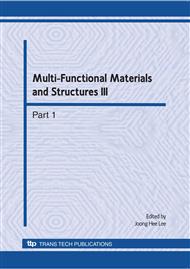p.899
p.903
p.907
p.911
p.915
p.919
p.923
p.927
p.931
Ultrasonic Inspection of Fiber Reinforced Cement Based Composites after their Exposure to Fire Conditions
Abstract:
Fiber reinforced cement based composites was exposed to high temperature conditions for up to 900oC and up to 2 hours and then they checked about their mechanical response and their convenience for ultrasonic wave transmission. Glass and polypropylene chopped fiber composites showed similar results. For low temperatures of exposure up to 300oC only a small variation of strength is appeared and a slight reduction of ultrasonic wave transmission. This is due to a corresponding water evaporation of wet not even hardened paste that is enclosed in small pores of cement composites. At the next stage and for temperature up to 800oC a steep drop of the mechanical strength of cement based composites is appeared. This reduction is accompanied by a corresponding decrease of ultrasonic wave velocity in the exposed specimens. The characteristic appearance of this stage is due to the dehydration process of calcium hydroxide that takes place at the temperature of about 400oC. At a third stage that starts from 800oC a total destruction of composite is appeared due to the decomposition of carbonate aggregates at 900oC. Typical sigmoidal curves were appeared according to temperature exposure, with that of ultrasonic wave transmission to be less steep, reaching values of 30% for an exposure of 900oC for 2 hours, whereas the mechanical strength for this level of exposure was less that 10% of the unexposed one.
Info:
Periodical:
Pages:
915-918
Citation:
Online since:
August 2010
Price:
Сopyright:
© 2010 Trans Tech Publications Ltd. All Rights Reserved
Share:
Citation:


